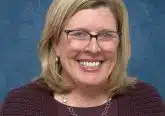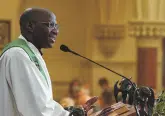Martyred religious brother from Wisconsin farm family to be beatified in Guatemala
Huehuetenango, Guatemala, Dec 7, 2019 / 03:58 am (CNA).- The son of Wisconsin farmers, Brother James Miller, FSC, was beatified Saturday, 36 years after he was shot and killed while working with school children and the indigenous poor in the country.
A graduate of St. Mary’s University in Winona, Minnesota and a member of the De La Salle Christian Brothers, Miller is remembered for his generosity, courage, and zeal to serve the children of Central America. He is the first member of his order in the United States to be beatified.
Brother Miller’s story strongly echoes that of Blessed Father Stanely Rother, another son of American farmers (this time from Oklahoma) who was murdered in Guatemala at his Santiago Atitlan mission, a mere seven months before Brother Miller’s murder. Rother was beatified in September 2017 in Oklahoma City. Both men are remembered for their courage, zeal for their mission, and their humility in their work.
“No one is perfect, and yet Jim, like a lot of people, did things very quietly, behind the scenes. He never asked for recognition,” Brother Pat Conway, who first knew Miller as a student and then as a fellow brother, told Minnesota newspaper Post Bulletin.
James Miller was born on Sept. 21, 1944, to a farming family near Stevens Point, Wis. He attended Pacelli High School, a Catholic school where he first encountered the Christian Brothers. Though he had also considered being a priest, Miller joined the order of brothers in September 1959, drawn to their apostolate in education.
Three years later in the novitiate program, he chose the religious name Brother Leo William, but eventually went back to using his baptismal name, which had become common among the brothers.
After teaching high school in Minnesota for three years, Miller made perpetual vows in 1970 and was sent to Bluefields, Nicaragua, fulfilling his desire to work in the missions in Central America. In 1974, he was transferred to Puerto Cabezas, Nicaragua, where he became the director of a school.
Using the name Brother Santiago while in Central America, Miller more than doubled the enrollment at the school during his five years there and headed the building of 10 additional schools in the area.
In 1979, he was called back to the U.S. by his superiors, who feared for his life after the Sandinista revolution that overthrew the Somoza government, for which Miller had worked. Prior to his return to the U.S., Miller acknowledged in a letter that he was aware of the growing violence around him, but he was not afraid.
“Are you kidding? I never thought I could pray with such fervor when I go to bed,” he wrote in a letter home, according to his order.
In January 1981, Miller was again sent back to Central America to a mission in Huehuetenango, Guatemala, where he taught at the Casa Indigena School and worked at a center teaching experimental agricultural techniques to indigenous Mayans. The skills were useful for the indigenous poor people, who had been bought out of their land by rich corporations in prior years, and were attempting to scrape by on farming in the mountains.
After just more than a year at the mission, on February 13, 1982, Miller had returned from taking students on a picnic and was shot in the back three times while repairing a wall at the school, the Post Bulletin reported. Miller died instantly, and his attackers were never identified. He was 37 years old.
Just seven months prior, on July 28, 1981, Father Stanley Rother had been shot and killed in the middle of the night at his mission in Santiago Atitlan, 100 miles to the south of Huehuetenango.
Just a month before his death, Miller had written in another letter: “I am personally weary of violence, but I continue to feel a strong commitment to the suffering poor of Central America… the Church is being persecuted because of its option for the poor. Aware of numerous dangers and difficulties, we continue working with faith and hope and trusting in God’s Providence.”
“I have been a Brother of the Christian Schools for nearly 20 years now, and commitment to my vocation grows steadily stronger in my work in Central America. I pray to God for the grace and strength to serve Him faithfully among the poor and oppressed in Guatemala. I place my life in His Providence. I place my trust in Him,” he added.
Those who knew Brother Miller remember him for his kindness, his generosity and his jovial spirit.
Brother Francis Carr, who roomed with Miller while they attended St. Mary’s University, told Winona Daily News that he remembers him as “a common, good guy.”
One of his former professors remembered Miller as “attractive with an open and sociable personality, likeable, completely genuine; people were captivated by his simplicity: he was very intelligent and also very simple.”
Another fellow brother recalled Miller as “an intelligent person, although not an intellectual, jovial, easy to relate with, preferring physical work to sports, with a deep faith and love for his religious vocation, but with a certain tendency to come late to class and community prayers.”
Conway remembered his fellow brother as “big and boisterous” and “very human.”
“What’s cool about him being beatified is that he was human,” Conway told the Post Bulletin. “The fact that someone so human would farm with these kids and taught them the skills to break the cycle of poverty. It speaks volumes about him.”
After his death, Miller’s body was sent back to the United States for burial in Wisconsin. Miller arrived in a dirty white robe, Conway told the Post Bulletin, because of all of the farmers who attended his funeral in Guatemala and wanted to touch his robes as they paid their respects.
Relics gathered during the exhumation of Miller’s body will be at the beatification in Guatemala, which will be celebrated on Saturday, December 7 in Huehuetenango.
Miller’s cause for canonization opened in 2009. Because Miller was officially declared a martyr by the Church, the typical requirement for proof of a miracle through his intercession in order to proceed with his beatification is waived. A miracle through his intercession will be needed before he can be canonized.
Representatives from St. Mary’s University will be present at the beatification in Guatemala, and a special concurrent commemoration ceremony will be taking place on campus.
“I think, particularly in the Catholic Church, in our faith, we highlight those who give their lives for the sake of the kingdom, the gospel, but also, in this case, as the gospel says, no one has greater love than to lay down his life for his friend,” SMU president Father James Burns told Winona Daily News.
“And so in following the example of Christ, this is what Brother James Miller did, laying down his life,” Burns added. “It’s a great honor for us to have someone for our local community being raised to this honor by the church.”
“I think people are instinctively drawn to goodness, that kind of goodness, even when it causes great sacrifice and we have to suffer. People are inspired by that.”













